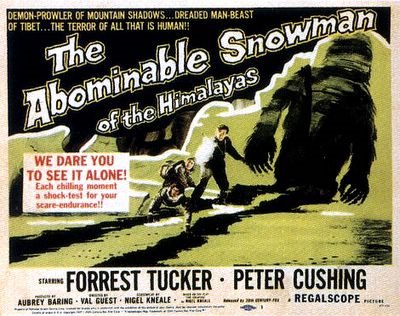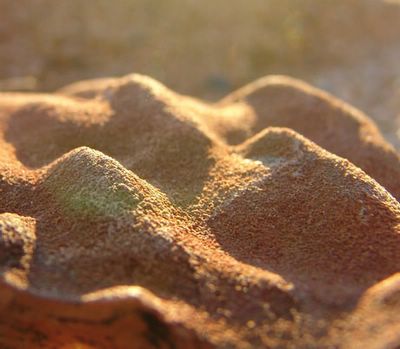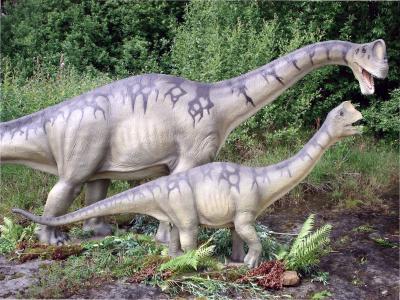Monday, June 26, 2006
To The Field
Saturday, June 24, 2006
Cretaceous Glaciers
Abstract: Paleontology is a data-rich science--so rich, in fact, that most geological dating using fossils has traditionally been based on just a minor subset of the total information available. This practice limits the resolution that can be achieved in dating, a particular problem when testing contentious theories about the existence of continental-scale ice sheets in the Cretaceous period, a time of global greenhouse climate. To demonstrate the presence of such ice sheets, it is necessary to prove that sea-level fluctuations resulting from apparent changes in ice volume were global and synchronous.
In this paper we use a newly-developed quantitative approach to integrate very large amounts of paleontological data and to date the geological evidence for sea-level changes in New Zealand. We show that some Cretaceous sea-level changes in New Zealand were apparently synchronous (with 92% probability) with changes in eastern United States, thereby supporting hypotheses of Cretaceous polar continental glaciation in the Cretaceous greenhouse world.
Friday, June 23, 2006
Spinning An Ancient Tale
New evidence indicates that the orb web common to two different groups of spiders had a single evolutionary origin and may have been snagging flying insects as early as 136 million years ago.From the AAAS press release:
New genetic evidence from one set of orb-web spinners called the Deinopoidea confirms that the group shares some key silk proteins with its fellow orb weavers the Araneoidea, according to Jessica Garb. Based on fossil evidence, the ancestor of the two spider groups probably lived at least 136 million years ago, making the orb web an ancient adaptation.
In addition to spiders that construct typical orb-webs, deinopoids include the ogre-faced, net-casting spiders that throw a modified orb web stretched between their legs over their prey. Araneoids include the orb weavers such as golden silk spiders with their traditional spiraling web as well as sheet-web weaving spiders. Garb says the finding "does not support a double origin for the orb web," but indicates that the unique design evolved only once.
Early Cretaceous Spider Web with Its Prey. 2006. E. Peñalver et al. Science 312: 1761In a second study researchers found pieces of a web with several insects still entangled encased in a 110-million year old piece of amber from a site in Spain.
Although Grimaldi and colleagues say there is not enough of the web preserved to know for sure, the parts that are preserved suggest an orb web design. In any case, Grimaldi says, the find indicates that the challenging silken traps of Early Cretaceous spiders may have put the pressure on many types of flying insects to evolve.
"Apparently, spiders have been fishing insects from the air for a very long time."
Thursday, June 22, 2006
Mesomyzon mengae, New Early Cretaceous Lamprey
Abstract: Widespread nowadays in freshwater and coastal seas of the cold and temporal zones, lampreys are a jawless vertebrate group that has been in existence for more than 300 million years but left a meagre fossil record. Only two fossil, lamprey species, Mayomyzon pieckoensis and Hardistiella montanensis, have been recognized with certainty from North American Carboniferous marine deposits.
We report a freshwater lamprey from the Early Cretaceous epoch (about 125 million years ago) of Inner Mongolia, China. The new taxon, Mesomyzon mengae, has a long snout, a well-developed sucking oral disk, a relatively long branchial apparatus showing branchial basket, seven gill pouches, gill arches and impressions of gill filaments, about 80 myomeres and several other characters that are previously unknown or ambiguous.
Our finding not only indicates Mesomyzon's closer relationship to extant lampreys but also reveals the group's invasion into a freshwater environment no later than the Early Cretaceous. The new material furthers our understanding of ancient lampreys, bridges the gap between the Carboniferous ones and their recent relatives, and adds to our knowledge of the evolutionary history of lampreys.
Royal Society Issues Statement On Teaching Evolution
The world's leading scientists Wednesday urged schools to stop denying the facts of evolution amid controversy over the teaching of creationism.
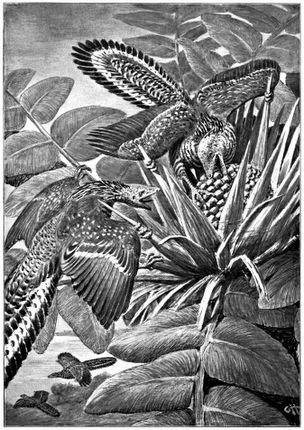
Archaeopteryx from Gerhard Heilmann's books 'Vor Nuvaerende Viden om Fuglenes Afstamning' (1916). Link
From The Guardian article by Rebecca Smithers:
The national science academies of 67 countries - including the UK's Royal Society - issued a joint statement warning that scientific evidence about the origins of life was being "concealed, denied, or confused". It urged parents and teachers to provide children with the facts about the origins and evolution of life on Earth.
The statement was drafted by members of the Inter Academy Panel on International Issues, a global network consisting of 92 science academies. It points out that "within science courses taught in certain public systems of education, scientific evidence, data, and testable theories about the origins and evolution of life on Earth are being concealed, denied, or confused with theories not testable by science".
Martin Rees, president of the Royal Society, said: "There is controversy in some parts of the world about the teaching of evolution to pupils and students, so this is a timely statement that makes clear the views of the scientific community.
"I hope this statement will help those who are attempting to uphold the rights of young people to have access to accurate scientific knowledge about the origins and evolution of life on Earth."
READ THE FULL STATEMENT FROM THE ROYAL SOCIETY HERE.
Wednesday, June 21, 2006
DINO TOWN

Our buddy Tom Bagley has a nice post up over at
7 Deadly Sinners on just a few of the seemingly hundreds of bad dinosaur sculptures that populate Drumheller, Alberta, home of the wonderful Royal Tyrrell Museum of Palaeontology.
I see that they’ve repainted the dinos for the summer and did up my personal fav, the Styracosaurus in front of the Valu Drug Mart, a fetching blue-ish tone. Ah, the stories I could tell about these things!
Note to Tom: pencil crayons are not un-hip!
Tuesday, June 20, 2006
Tinker, T. rex, Trouble
Ed tells me that Tinker used to have a website, kidrex.com, and that you can still access a partial archive of the website through archive.org and HERE.
According to the old site:
"Tinker" is the near-complete skeleton of a rex youngster, an individual two-thirds adult size, but only one-fourth adult weight. We think we have over 70% of Tinker with at least something from each section of the body, from jaws to tail tip vertebrae."Also from the site:
The Discovery Team was Ron "Tinker" Frithiof, Mike Harrell, Melody Harrell, Kim Hollrah with Dr. Robert T. Bakker, paleontologist and D.L. Grimm & Associates, marketing and promotion.Dan also points us to a post over at the Dinosaur Mailing List (hosted by the CMNH) that explains all.
Has there been a T.rex dug up since ‘Sue’™ that has NOT caused trouble for someone? Let’s cue up Alan Price singing a reworked version of “The House of The Rising Sun” as we ride into the night:
They call the [insert ‘cute’ name]
And it's been the ruin of many a poor boy
And God I know I'm one”
Giraffe Necks & Big-Hearted Sauropods

From Science Now:
“Thanks to its long neck, a giraffe's head can rise up to 5 meters in mere seconds after the creature takes a drink. One would expect this dramatic motion to trigger a massive drain of blood from the brain, but giraffes obviously aren't fainting all over the place.
To solve the dizzying conundrum built a machine that replicated the length, rigidity, and pressure of the blood-flow system in a giraffe's neck. Rubber or PVC tubes substituted for the jugular vein and carotid artery, an electric pump became the heart, and water was used instead of blood.
 The siphon model only worked when stiff PVC tubing was used. When the researchers substituted rubber tubing, which more closely matches the flexibility seen in giraffe blood vessels, "blood" was not sucked up into the "brain."
The siphon model only worked when stiff PVC tubing was used. When the researchers substituted rubber tubing, which more closely matches the flexibility seen in giraffe blood vessels, "blood" was not sucked up into the "brain."Making the "heart" do all the work, however, solved the problem: "blood" efficiently reached the "brain" even when rubber tubing was used.
The model explains why a giraffe's blood pressure is about twice as high as that seen in people, says Mitchell. He suspects that a muscular cuff at the base of the jugular vein constricts as the giraffe stands to maintain that pressure in the brain.”
Monday, June 19, 2006
Lease of Juvenile T. rex Land Invalid
The remains of a juvenile Tyrannosaurus rex unearthed from northwest South Dakota in 1998 eventually could be headed back to the state.
A federal judge has ruled that a lease between Harding County and the team of fossil hunters that dug up the fossil, nicknamed Tinker, was invalid because it did not follow South Dakota law.
Ken Barker, a Belle Fourche, S.D., attorney representing Harding County, said the effect of the order is that the county owns Tinker and any other dinosaurs found on its site. But the homecoming for Tinker, 65 million years old and believed to be about 90 percent complete, is not certain.
The T. rex is sitting in storage in Pennsylvania under the jurisdiction of a federal bankruptcy court after the man hired to restore the fossils filed for Chapter 7 bankruptcy protection.
Sunday, June 18, 2006
The Land Unknown!
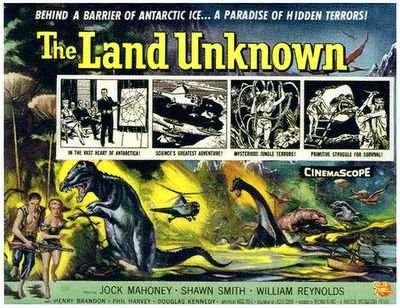
“In 1957, an expedition led by Commander Allen Roberts (Jock Mahoney), and including reporter Margaret Hathaway (Shawn Smith) and Lt. Jack Carmen (William Reynolds), heads via helicopter to the Antarctic. However, they are forced to make an emergency landing and touch down in a Mesozoic-era time warp, where dinosaurs roam and carnivorous plants dot the landscape. Soon they meet mad explorer Carl Hunter (Henry Brandon), who has lived in this amazing place ever since his own helicopter crashed ten years earlier. The group tries to organize an escape while staying free of hungry flora and fauna.”Synopsis from HERE.
Watch the tralier in glorious B&W!:
Saturday, June 17, 2006
Bob Bakker Vs. Harry Potter

Bob Bakker calls in the experts to consult on details of the new pachycephalosaur, Dracorex hogwartsia, at a recent event at the Houston Museum of Natural History.
Friday, June 16, 2006
Gansus, Earliest Amphibious Bird
At about 110 million years, Gansus yumenensis is one of the oldest members of the lineage leading to modern birds. New fossil specimens of the loon-like ancient bird help fill in the avian family tree and suggest that today's birds may have gotten their start in aquatic environments.From the AAAS press release:
The five well-preserved fossils of Gansus described include nearly complete skeletons consisting of three-dimensional, mostly uncrushed bones. Several of the specimens are so exquisitely preserved that the carbonized remains of feathers and even webbing in the foot can be seen clearly.
Details in the hind legs and feet of Gansus indicate that the bird was probably a foot-propelled diver like today's grebes, loons, and many ducks, although they may not have been as good at diving as their modern counterparts, according to Hai-lu You. Gansus belongs to a lineage of birds called the Ornithurae, which includes all modern birds (Neornithes) and their immediate fossil ancestors. Gansus is not a member of the Neornithes, but it is the oldest known ornithurae. Ornithuran birds probably arose in the Early Cretaceous, sometime between 140 and 110 million years ago.
The new fossils were discovered by You and his team near the town of Changma, about 2,000 km west of Beijing, where the first Gansus fossil (a partial hind leg) was found in 1981. Most of the nearly 50 bird specimens found so far at the site appear to be Gansus, the researchers say, which would make it the oldest known fossil locality dominated by ornithuran birds.
Abstract:Three-dimensional specimens of the volant fossil bird Gansus yumenensis from the Early Cretaceous Xiagou Formation of northwestern China demonstrate that this taxon possesses advanced anatomical features previously known only in Late Cretaceous and Cenozoic ornithuran birds. Phylogenetic analysis recovers Gansus within the Ornithurae, making it the oldest known member of the clade. The Xiagou Formation preserves the oldest known ornithuromorph-dominated avian assemblage. The anatomy of Gansus, like that of other non-neornithean (nonmodern) ornithuran birds, indicates specialization for an amphibious life-style, supporting the hypothesis that modern birds originated in aquatic or littoral niches.
Peace
The poster is part of the show entitled ‘The Graphic Imperative” that is a collection of posters for peace, social justice, and the environment ranging from the years 1965-2005. It’s at the AIGA national Design Center in New York City until August 18, 2006.
Thanks to Drawn! for the alert on this.
Butterfly Speciation Via Hybridization
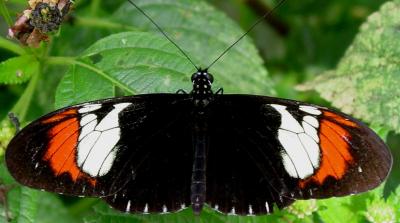
In a matter of months, butterflies sporting the yellow and red wing color pattern of a wild species were created through simple laboratory crosses of two other wild species.From the press release:
"We recreated the evolutionary steps that may have given rise to Heliconius heurippa, a hybrid butterfly species, in the lab," explains Jesus Mavarez.
Sexual encounters between species resulting in hybrid offspring may be common in nature. However, homoploid hybrid species -- fully sexual hybrid species resulting from crosses between two different parent species -- are still considered to be quite rare. This report of the laboratory creation of a hybrid butterfly nearly identical to a known wild species, and the observation that hybrid individuals don't mate with either parent species, provides the most convincing case to-date for homoploid hybrid speciation in animals.
The process of speciation usually occurs when one species splits into two, but there are some cases in which new species result from the mating between two good species. Usually when members of different species mate, their offspring die or are infertile. On occasion, polyploid hybrids -- individuals with multiple copies of their parents' chromosomes, survive and establish a new lineage or species. Polyploid hybrid speciation often occurs in plants when polyploid individuals go on to reproduce asexually. Some lizards, frogs, fish and many invertebrates also pull this trick.
Thursday, June 15, 2006
Isisfordia, New Fossil Croc From Australia
A new fossil from the Age of the Dinosaurs suggests modern crocodiles first evolved in Gondwana.From ABC News:
The fossilised remains of the most primitive ancestor of modern crocodiles were discovered near an outback Australian town
 in Queensland. Until now the kinds of creatures that seemed to be the ancestors of all modern crocodiles have come from places like Belgium, from England, from the USA," says team member Dr Paul Willis.
in Queensland. Until now the kinds of creatures that seemed to be the ancestors of all modern crocodiles have come from places like Belgium, from England, from the USA," says team member Dr Paul Willis.But he says the new specimen, Isisfordia duncani, shares more features in common with modern crocodiles than any specimens found in the northern hemisphere. The 98 to 95 million years old, Isisfordia predates modern crocodiles by about 20 million years.
Willis and colleagues analysed two fossilised skeletons first discovered in the mid-1990s in a creek bed in Isisford, in central-western Queensland, by former deputy mayor of the town, Ian Duncan. One specimen is almost a complete skeleton with just the snout and face of the crocodile missing. The other is a complete skull.
"Between the two we have a complete skeleton," says Willis. "We know what the whole animal looked like and it's very rare to get that."
Read the rest of the article HERE.
Image: The palaeoblogger's old buddy, Matt Herne
Summer Field Work


Tuesday, June 13, 2006
'Extinct' Laotian Rock Rat Captured
The first images of a live specimen of a small, furry animal once believed to have gone extinct more than 11 million years ago have been captured during a Southeast Asian expedition led by a retired Florida State University researcher.

Laotian Rock Rat courtesy of David Redfield.
The remarkable video and photos shot by David Redfield, a professor emeritus of FSU's science education faculty, and Thai wildlife biologist Uthai Treesucon are being hailed as historic images documenting a true "living fossil," the Laotian rock rat.
Redfield's video shows a docile, squirrel-sized animal covered with dark, dense fur and bearing a long tail that's not as bushy as that of a typical squirrel. Perhaps the most striking observation is how the animal walks -- like a duck. Clearly not adapted to climbing trees, the rock rat exhibits a duck-like waddle with its hind feet splayed out at an angle to its body.

Laotian Rock Rat courtesy of David Redfield.
The Laotian rock rat so called for its only known habitat -- limestone outcroppings in Central Laos -- and the appearance of the animal's head and face, which sport long whiskers and beady eyes like those of a rat.
To view photographs and video of the Laotian rock rat, visit RockRat.
New Shark Species Discovered
A new species of hammerhead shark has been discovered off the coast of South Carolina. The newfound shark species, which has not yet been named, is nearly identical to the scalloped hammerhead, a common Atlantic shark that can grow up to 3 meters long.

Photo from National Geographic News
But the new species appears to be extremely rare—so much so that it may only breed in certain South Carolina bays. Biologists at Nova Southeastern University in Fort Lauderdale, Florida, discovered the new species while studying the DNA of scalloped hammerheads. The researchers found that some hammerheads they examined had a significantly different genetic signature from the rest, despite their similar appearance.
A separate team led by Joe Quattro at the University of South Carolina in Columbia came to the same conclusion while studying the state's coastal shark stocks.
Protein Parallel Evolution
Jianzhi Zhang presents evidence an example of parallel evolution in a gene for an enzyme that helps leaf-eating monkeys digest their food.
 "We know that parallel, or convergent, evolution is very common at the level of morphology—birds can fly, insects can fly, bats can fly, and they've all evolved this capability independently. But at the DNA and protein sequence level, it's very rare to find parallel evolution.”
"We know that parallel, or convergent, evolution is very common at the level of morphology—birds can fly, insects can fly, bats can fly, and they've all evolved this capability independently. But at the DNA and protein sequence level, it's very rare to find parallel evolution.”The new work builds on previous research in which Zhang showed that the duplication of a gene encoding a pancreatic enzyme helped Asian colobine monkeys cope with an unusual diet and is reported in the current issue of Nature Genetics.
Monday, June 12, 2006
Outback Dinosaurs

Muttaburrasaurus © Luis Rey from his site
The Courier Mail has a nice article on some of the dinosaur and other fossil localities found in the Outback of Australia. Here’s an excerpt:
"It was 200km south of Hughenden, at Muttaburra, that Doug Langdon found a strange pile of fossilised bones in 1963 and put his town on the international palaeontology map.
Langdon's skeleton, Muttaburrasaurus langdoni, ended up in the Queensland Museum and the town got a gaudy replica of the dinosaur to put up in its main street – an exchange that some in Muttaburra have resented ever since.
There is said to be another complete dinosaur skeleton lying in a paddock close to town, but its supposed location has not been revealed.
Not that fossilised dinosaurs are in short supply in this country. In 1989, Richmond district brothers Ian and Rob Ievers dug an almost complete skeleton of a 100-million-year-old plesiosaur out of the ground on their family property, and found another preserved dinosaur skeleton of an armoured ankylosaur three months later."
Sunday, June 11, 2006
TyranoStar: King of the Dinosaurs!

Tyranostar™ & © Pete Von Sholly
Sort of a ‘Land of the Lost’ crossed with ‘The Mighty Mightor’ it harkens back to best of 70’s Saturday morning cartoon shows. Below are some new unpublished pages by Pete.
But that’s not all! Pete has produced a trailer for the book that explains who and what ‘TyranoStar’ is (with a cool soundtrack). Enjoy!
Find more of Pete's videos at YouTube.com by searching the key word 'VONREX'.
Saturday, June 10, 2006
Happy Birthday To: E.O. Wilson
Wilson's On Human Nature (1978) won the Pulitzer Prize; Biophilia (1984) suggests that human attraction to other living things is innate; and Consilience (1998) urges wider integration of the sciences. Other books by Wilson are Insect Societies (1971), The Diversity of Life (1992), The Ants, with Bert Hölldobler (1990; Pulitzer Prize), and The Future of Life (2002).
Wilson’s latest book is The Creation: A Meeting of Science and Religion. Info from Infoplease.com
Friday, June 09, 2006
Melting The Last Ice Age
Dates on moraines from mid-latitudes around the world imply that after the last Ice Age glaciers retreated simultaneously in response to warming by increased CO2 levels.Near-Synchronous Interhemispheric Termination of the Last Glacial Maximum in Mid-Latitudes. 2006. Joerg M. Schaefer. Science 312: 1510 – 1513.
From the press release of the Earth Institute at Columbia University:
A new study indicates that, except for regions of the North Atlantic, most of the Earth began warming at the same time roughly 17,500 years ago. In addition, scientists suggest that ice core records from Greenland, which show that average temperatures there did not warm appreciably until about 15,000 years ago, may have remained in a hyper-cold state largely as a result of events triggered by warming elsewhere.
The researchers relied on a method known as cosmogenic or surface-exposure dating, which enabled the scientists to determine how long rock surfaces have been exposed since the glaciers retreated. As cosmic rays penetrating the Earth's atmosphere strike the scoured rock, they form an isotope of the element beryllium, 10Be, at a known rate. By measuring the minute amounts of 10Be in rock samples from glacial moraines in California and New Zealand and comparing these data to previously published results from elsewhere they could determine when the glaciers retreated. They found that almost everywhere they looked the glaciers began to pull back approximately 17,500 years ago.
Info on life after ‘Snowball Earth’ HERE
Thursday, June 08, 2006
Articles of Note: Comptes Rendus Palevol.
Abstract: Archosaurian reptiles evolved a more erect posture and parasagittal gait early on. Early dinosaurs were the first habitual striding bipeds, a trait retained by living birds. Yet there is much more to archosaur locomotor evolution than these two transitions. I review our understanding of the pattern of locomotor evolution from the first archosaurs to Crocodylia and Neornithes, outlining where transitions of locomotor function evolved. I evaluate current research approaches, advocating more experimental work on extant animals to establish rigorous form–function relationships, and more biomechanical research that is bolstered by validation and sensitivity analysis of its assumptions, methods, and results.
Time recording in bone microstructures of endothermic animals; functional relationships. 2006. Jacques Castanet. Comptes Rendus Palevol 5: 629-636.
Abstract: Because they are mineralized, skeletal tissues can record and preserve indefinitely in their microstructures the expression of various constraints and especially the passage of time. Such traces of time can be either continuous or periodic (growth marks), but when deciphered they offer a powerful tool to reconstruct life history traits and even ecological conditions of time in extant as well as extinct species. Nevertheless, the temporal message ‘printed’ in skeletal tissues can be disturbed or even destroyed by various causes that need to be understood before this ‘biological chronometer’ can be accurately used.
Wednesday, June 07, 2006
Stromatolites Evidence of Earth's Oldest Life
The new analysis presents several lines of evidence that support the idea that stromatolites were formed by mats of microscopic organisms.Abstract: The 3,430-million-year-old Strelley Pool Chert (SPC) (Pilbara Craton, Australia) is a sedimentary rock formation containing laminated structures of probable biological origin (stromatolites).
Determining the biogenicity of such ancient fossils is the subject of ongoing debate. However, many obstacles to interpretation of the fossils are overcome in the SPC because of the broad extent, excellent preservation and morphological variety of its stromatolitic outcrops—which provide comprehensive palaeontological information on a scale exceeding other rocks of such age.
Here we present a multi-kilometre-scale palaeontological and palaeoenvironmental study of the SPC, in which we identify seven stromatolite morphotypes—many previously undiscovered—in different parts of a peritidal carbonate platform. We undertake the first morphotype-specific analysis of the structures within their palaeoenvironment and refute contemporary abiogenic [non-living] hypotheses for their formation. Finally, we argue that the diversity, complexity and environmental associations of the stromatolites describe patterns that—in similar settings throughout Earth's history—reflect the presence of organisms.
Europasaurus holgeri: Germany's Pygmy Dinosaur
From the press release:
Scientists have determined that the unusually small dinosaur fossils of the new brachiosaurid Europasaurus holgeri which were found in a quarry on the northern edge of the Harz Mountains in 1998, likely were adults. At a maximum estimated weight of one tonne they were only a fiftieth the weight of their closest relatives, the brachiosaurs, and thus by far the smallest of the giant dinosaurs which have ever been found.
The tightly compressed ‘growth rings’ indicate that the dinosaurs must have been fully grown when they died. 'They stopped growing when they reached 6 metres in length and a tonne in body mass,' Martin Sander (below) estimates. Their cousins, by contrast, were up to 45 metres long and weighed in at 80 tonnes – the biggest land animals which have ever existed.
The material comes from 150 million year old islands in the area that is now Germany. This island situation may well be the reason why the 'pygmy dinosaurs' evolved -- smaller animals which needed less food had better chances of survival,' explains Nils Knötschke of the Dinopark in Münchehagen, who has exposed more than 80 per cent of the bones found and also headed the excavations in the quarry. 'Shrinkage like this due to a reduction in the food available can take place extremely rapidly, sometimes within 10 or 20 generations,' Dr. Sander confirms.
An international team of scientists have excavated and preserved more than 1000 dinosaur fossils in the quarry since 1998. The life-size models of the mini-dinosaur pictured above can be seen in the Münchehagen dinosaur park. The quarry has also produced pterosaurs, crocodiles, tortoises, and theropod footprints.
Abstract: Sauropod dinosaurs were the largest animals ever to inhabit the land, with truly gigantic forms in at least three lineages. Small species with an adult body mass less than five tonnes are very rare, and small sauropod bones generally represent juveniles. Here we describe a new diminutive species of basal macronarian sauropod, Europasaurus holgeri gen. et sp. nov., and on the basis of bone histology we show it to have been a dwarf species. The fossils, including excellent skull material, come from Kimmeridgian marine beds of northern Germany, and record more than 11 individuals of sauropods 1.7 to 6.2 m in total body length. Morphological overlap between partial skeletons and isolated bones links all material to the same new taxon. Cortical histology of femora and tibiae indicates that size differences within the specimens are due to different ontogenetic stages, from juveniles to fully grown individuals. The little dinosaurs must have lived on one of the large islands around the Lower Saxony basin. Comparison with the long-bone histology of large-bodied sauropods suggests that the island dwarf species evolved through a decrease in growth rate from its larger ancestor.
Sunday, June 04, 2006
Devil Dinosaur: A Fossil Fragment
Saturday, June 03, 2006
Born This Day: James Hutton
Friday, June 02, 2006
Electric Fish Spark New Species?
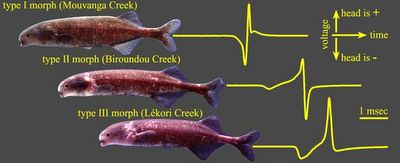
Credit: John Sullivan via Cornell University
From Sara Ball at CU Chronicle Online:
Electric fish in the Ivindo River in have different DNA, different communication patterns and won't mate with each other. However, two types of electric signals are now known from fish that have the same DNA.
The researchers' conclude that the fish appear to be on the verge of forming two separate species.
"We think we are seeing evolution in action," said Matt Arnegard, a postdoctoral researcher at Cornell U. Some of these fish violate an otherwise regular pattern of mating behavior, and so could be living examples of a species of fish diverging into separate species.
The electric fish -- known as mormyrids -- emit weak electric fields from a batterylike organ in their tails to sense their surroundings and communicate with other fish. Each species of mormyrid gives off a single characteristic electric impulse resulting in the flash of signals, indicating, for example, aggression, courtship and fear.
Because all of the 20 or so species of mormyrid have distinct electric signals, Arnegard believes the different impulses of the fish he studies might be their first step in diverging into different species.
One the other hand, the fish could be a single species. "This could be just a polymorphism, like eye color in humans, that violates the fishes' general evolutionary pattern but doesn't give rise to separate species," said Arnegard, who will return to Gabon in June to conduct further tests.
300 Mile-Wide Impact Crater In Antarctica
Planetary scientists have found evidence of a meteor impact much larger and earlier than the one that killed the dinosaurs -- an impact that they believe caused the biggest mass extinction in Earth's history.

GRACE-measured gravity fluctuations beneath East Antarctica. Denser regions appear more red; the location of the Wilkes Land crater is circled (above center). Image courtesy of Ohio State University.
The 300 mile wide crater lies hidden more than a mile beneath the East Antarctic Ice Sheet. And the gravity measurements that reveal its existence suggest that it could date back about 250 million years -- the time of the Permian-Triassic extinction, when almost all animal life on Earth died out.
Its size and location -- in the Wilkes Land region of East Antarctica, south of Australia -- also suggest that it could have begun the breakup of the Gondwana supercontinent by creating the tectonic rift that pushed Australia northward.
Scientists believe that the Permian-Triassic extinction paved the way for the dinosaurs to rise to prominence. The Wilkes Land crater is more than twice the size of the Chicxulub crater in the Yucatan peninsula, which marks the impact that may have ultimately killed the dinosaurs 65 million years ago. The Chicxulub meteor is thought to have been 6 miles wide, while the Wilkes Land meteor could have been up to 30 miles wide -- four or five times wider.
"This Wilkes Land impact is much bigger than the impact that killed the dinosaurs, and probably would have caused catastrophic damage at the time," said Ralph von Frese, a professor of geological sciences at Ohio State University.
"Based on what we know about the geologic history of the region, this Wilkes Land [site] formed recently by geologic standards -- probably about 250 million years ago," he said.
Von Frese and Laramie Potts, a postdoctoral researcher in geological sciences reported their preliminary results in a recent poster session at the American Geophysical Union Joint Assembly meeting in Baltimore.
Modeling the Late Cretaceous Greenhouse Climate
From the pres release from University of Newcastle upon Tyne:
New scientific results for the Late Cretaceous greenhouse indicate radically different climatic mechanisms operating about 75-90 million years ago compared to the ones that control today's climate.
These new results challenge current notions on role of the tropics as main driver of Cretaceous climate. They rather support the conclusion that tropical climate in a greenhouse world is ultimately triggered by climate change at mid-southern latitudes, with precipitation and river discharge being the transport mechanisms.
Thursday, June 01, 2006
Fossil Frogs Predict Rain

link
Precipitation is an important geodynamic control factor coupled to tectonics, erosion, continental run-off, weathering, and oceanic circulation. But in practice this climate parameter is difficult to estimate.
Existing methods for determining paleo-precipitation are either subject to large errors (± 350–400 mm or more using mammalian proxies) or restricted to wet climate systems due to their strong facies dependence (paleobotanical proxies). Böhme et al. describe a new tool to estimate paleo-precipitation based on an indexing of the frequency of eco-physiologic groups within fossil amphibian and reptile communities.
In recent communities, these indices show a highly significant correlation to annual precipitation (r2 = 0.88) and will yield paleo-precipitation estimates with average errors of ± 250–280 mm. Knowledge about fossil amphibians and reptiles has increased dramatically over the last decade, and large distribution databases also exist. Therefore, the new method will widely extend the applicability of precipitation estimates in the geological past.
More Hobbit News: Island Tools Predate Modern Humans
An analysis of tools from a site called Mata Menge are strikingly similar to those found at the nearby H. floresiensis locality dated at 800,000 years ago.From National Geographic News:
The similarity between the two sites suggests that H. floresiensis humans—who had tiny, grapefruit-size brains—were capable craftspeople who inherited their toolmaking tradition from ancestors who evolved on Flores, researchers said. Both sets of tools from the Liang Bua cave and the older Mata Menge archaeological site share hallmarks of simple but sophisticated flaking and shaping.
Previously some scientists had cited the complexity of the Flores stone tools as evidence that the hobbit-like people were diseased modern humans rather than a unique species.
Read the rest HERE. Get more info HERE.
Toyonian Mass Extinction
Glass and Phillips present new geochemical and geochronological data that link scattered Cambrian basalt suites across northern and central Australia into a single large igneous province (LIP). This newly identified province, named the Kalkarindji Continental Flood Basalt Province (CFBP), is Australia's largest
 and oldest Phanerozoic igneous province. The province covers an area of at least 1 million square kilometers with an estimated original volume exceeding 0.5 million cubic kilometers, which ranks the province with other CFBP's such as the Deccan, Parana, and Karoo LIP's, in terms of size.
and oldest Phanerozoic igneous province. The province covers an area of at least 1 million square kilometers with an estimated original volume exceeding 0.5 million cubic kilometers, which ranks the province with other CFBP's such as the Deccan, Parana, and Karoo LIP's, in terms of size. New high-precision 40Ar/39Ar ages suggest that the newly identified Kalkarindji CFBP may be linked to the early Toyonian mass extinction event at the Early/Middle Cambrian boundary, thus providing the oldest-known possible link between a LIP and a mass extinction event.
Image link










